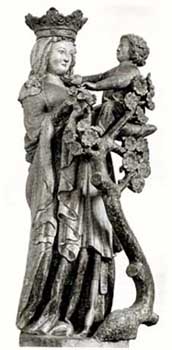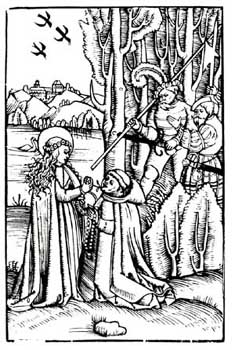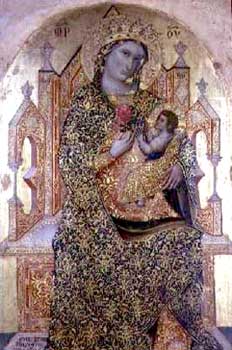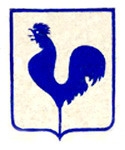 |
Stories & Legends
The Roses and the Rosary
Margaret Galitzin
When I was in fifth grade, a good Irish Daughter of Charity did her best to transmit to her class not just the perfunctory practice of the Rosary, but a love of the Rosary. When we said the Rosary in the month of October, she told us to imagine that we were making a garland of roses for the Blessed Virgin with every five decade Rosary. Each Hail Mary was a white rose to honor her exquisite purity; each Our Father a red rose honoring the Blood Our Lord shed for love of us.

Our Lord, on a rose tree, embraces the Virgin Mary
13th century, Straubing, Munich |
This was a practice not just for the girls of the class, who naturally like to make flower garlands, but also the boys. For when a young man wants to make his mother happy and show how much he loves her, he brings her flowers. And the most beautiful and precious of flowers is the rose.
It was a very beautiful lesson, given with that bit of Irish fantasy and poetry that flows naturally in Gaelic veins, to encourage us to an intimacy with Our Lady. She didn’t stress duty, the benefits to be gained, the favors to ask through the Rosary – all true enough. No, she wanted us to pray the Rosary to please Our Lady, to make her happy, to show our love for her.
This was much the spirit that inspired the Rosary, originally called the Psalter of Mary. In place of reciting the 150 psalms of the Divine Office, the prayer offered by priests and religious on behalf of the whole Church, the simple people took up the practice of reciting the Pater Noster (Our Father) 150 times. Later, they took to saying 150 Hail Mary’s, subdivided into three sets of 50 stanzas, each set designated as a chaplet. It was “the Psalter of Our Lady,” and the people prayed it to add their voices to the prayer of the Church and to please the Blessed Virgin. They wanted to bring Holy Mary delight by recalling to her the joy of the Incarnation through the recitation of the Ave Maria, the Archangel Gabriel’s greeting to Mary found in the Gospel of St. Luke (1:28).
By the late Middle Ages, the vox populi, the voice of the people, had replaced the name Psalter with Rosary, or rosarium in Latin, meaning a “crown of roses.” One inspiration for the name was the idea of placing on the heads of Jesus and Mary garlands of 150 white roses and sixteen red roses, roses that never wilt or lose their beauty.
Hail-Marys seen as roses
One of the earliest mentions of Aves taking the form of roses and comprising garlands occurs in the story, “Aves seen as Roses,” which appears in the 13th century in Latin, Catalan and German versions. Later, this story was included in almost all the Rosary confraternity handbooks to demonstrate how much this pious practice pleased Our Lady.
What is the story? Here it is.
A good, simple secular man had the daily practice of making a chaplet of roses, or whatever flower he could find according to the season, and placing it on the head of a statue of Our Lady. He did this with great joy and pious devotion.

Robbers see Ave-Marias as roses issuing from the mouth of the monk |
The Virgin saw the good intention of his heart, and wanting to help him further it, gave him the desire to take up the religious life. And so he became a lay brother in a cloister. But in the cloister he was given so many tasks to perform that he no longer had time to make Mary her chaplet as he was accustomed to do. For this reason, he became dissatisfied. He was about to leave the order and return to the world, when an older priest became aware of his distress. The priest wisely advised him that he should recite each day 50 Ave Marias in place of the chaplet and convinced him that the Virgin Mary would prefer that to all the rose chaplets that were ever made. The lay brother followed the advice and continued in it for some time.
Then one day he was sent on an errand that required him to ride through a forest that harbored thieves. In the forest he tied his horse to a tree, knelt down and was reciting his 50 Ave Marias when thieves saw him and decided to rob him and steal his horse. But as they approached him, they saw from a distance a wonderfully beautiful maiden standing by him who, every little while, took from his mouth a beautiful rose and added it to a garland that she was making. When the rose chaplet was complete, she placed it on her head and flew off to Heaven.
The robbers were thoroughly amazed and ran to the brother asking him who the beautiful maiden was that they had seen beside him. The lay brother replied: “I did not have any maiden with me. I have only been reciting 50 Ave Marias as a chaplet for Queen Mary, as I was instructed. That is all I know.”
When the robbers told him what they had seen, the lay brother and the robbers too realized that it was the Holy Mother of God who, in person, had accepted the rose chaplet that he was accustomed to send to her daily... Then the brother rejoiced from the depths of his heart, and from that day forward, made a spiritual rose chaplet of 50 Ave Marias for Queen Mary daily and instructed other good people in the practice. In this manner the rosary was created and made known to us. And one may believe that the robbers better their lives as a result, because God’s grace had permitted them to behold the Mother of Mercy.
More than a tale
Today there is a tendency to smile at “medieval stories” like this one. Those were simple-minded people who believed in all kinds of superstitions and myths, so of course they understood it literally. On the other hand, we are a more sophisticated and highly developed people, so of course we don’t actually believe such a thing really occurred.

Our Lady of the Rose |
In his work Secret of the Rosary, St. Louis de Montfort warns us against taking such a high-minded attitude about well-authenticated stories about holy subjects told by trustworthy authors. One of the Devil’s traps is to foster the spirit of pride and make man deny tradition and doubt anything he cannot see, does not understand, or simply does not like. This is not a superior man, but the stupid man who no longer steps securely and one who can well end in heresy.
How many times has Our Lady shown her approval of the praying of the Rosary with miracles! The Jesuit Fr. Alfonso Rodriguez used to mediate on the mysteries of the Rosary with such fervor that he often saw a red rose come out of his mouth at each Our Father that he said, and white rose at each Hail Mary, both equal in beauty and differing only in color. Let the skeptics sneer and scoff in their pride. The saintly Jesuit believed and was rewarded by Our Lady with a visible demonstration of her pleasure in the Rosary prayed with persistent dedication.
By all means, then, let us recite the entire Rosary every day, that is to say, three rosaries each of five decades, which we can liken to three garlands or crowns of flowers. We should also meditate on its more profound meaning:
- First, we pray the three rosaries to honor the three crowns of Jesus and Mary: the crown of grace at the time of His Incarnation, His crown of thorns during his Passion, and His crown of glory in Heaven.
- Second, we do this so that we ourselves may receive three crowns from Our Lord and Our Lady: a crown of merit during our lifetimes, a crown of peace at our deaths, and a crown of glory in Heaven.

Posted October 24, 2006


Related Topics of Interest
 Our Lady of the Rosary Our Lady of the Rosary
 The Rosary: A Weapon for Our Times The Rosary: A Weapon for Our Times
 Praying the 15 Decades of the Rosary Praying the 15 Decades of the Rosary
 Don’t Forget Sacramentals - Aids to the Spiritual Life Don’t Forget Sacramentals - Aids to the Spiritual Life
 Remember Lepanto! Remember Lepanto!
 La Conquistadora - Our Country's Oldest Madonna La Conquistadora - Our Country's Oldest Madonna
 The Symbol of the Crown in the Reign of Mary The Symbol of the Crown in the Reign of Mary
 Symbolism of the Snow Symbolism of the Snow

|
Legends | Religious |
Home | Books | CDs | Search | Contact Us | Donate

© 2002-
Tradition in Action, Inc. All Rights Reserved
|
 |
|